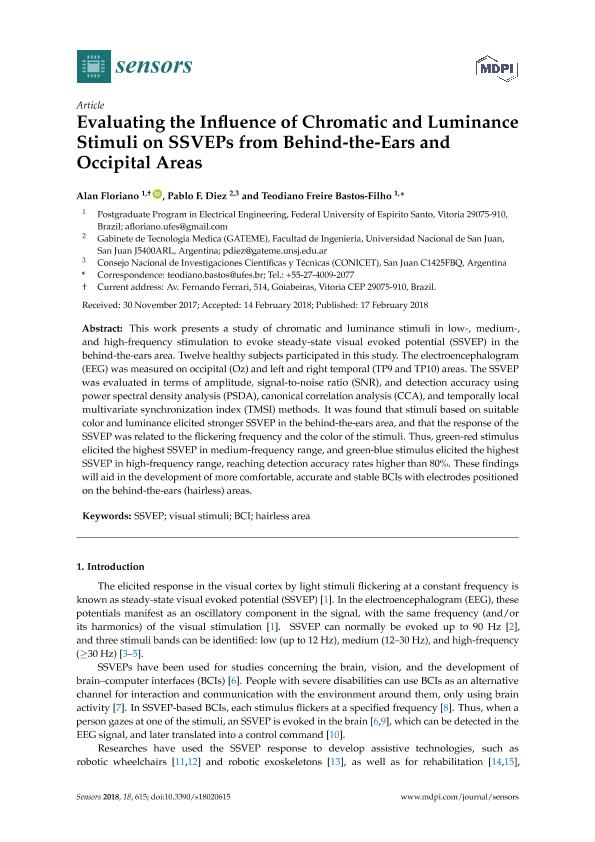Mostrar el registro sencillo del ítem
dc.contributor.author
Floriano, Alan
dc.contributor.author
Diez, Pablo Federico

dc.contributor.author
Freire Bastos Filho, Teodiano
dc.date.available
2022-05-06T13:38:58Z
dc.date.issued
2018-02
dc.identifier.citation
Floriano, Alan; Diez, Pablo Federico; Freire Bastos Filho, Teodiano; Evaluating the influence of chromatic and luminance stimuli on SSVEPs from behind-the-ears and occipital areas; Molecular Diversity Preservation International; Sensors; 18; 2; 2-2018; 1-12
dc.identifier.issn
1424-8220
dc.identifier.uri
http://hdl.handle.net/11336/156772
dc.description.abstract
This work presents a study of chromatic and luminance stimuli in low-, medium-, and high-frequency stimulation to evoke steady-state visual evoked potential (SSVEP) in the behind-the-ears area. Twelve healthy subjects participated in this study. The electroencephalogram (EEG) was measured on occipital (Oz) and left and right temporal (TP9 and TP10) areas. The SSVEP was evaluated in terms of amplitude, signal-to-noise ratio (SNR), and detection accuracy using power spectral density analysis (PSDA), canonical correlation analysis (CCA), and temporally local multivariate synchronization index (TMSI) methods. It was found that stimuli based on suitable color and luminance elicited stronger SSVEP in the behind-the-ears area, and that the response of the SSVEP was related to the flickering frequency and the color of the stimuli. Thus, green-red stimulus elicited the highest SSVEP in medium-frequency range, and green-blue stimulus elicited the highest SSVEP in high-frequency range, reaching detection accuracy rates higher than 80%. These findings will aid in the development of more comfortable, accurate and stable BCIs with electrodes positioned on the behind-the-ears (hairless) areas.
dc.format
application/pdf
dc.language.iso
eng
dc.publisher
Molecular Diversity Preservation International

dc.rights
info:eu-repo/semantics/openAccess
dc.rights.uri
https://creativecommons.org/licenses/by/2.5/ar/
dc.subject
SSVEP
dc.subject
VISUAL STIMULI
dc.subject
BCI
dc.subject
HAIRLESS AREA
dc.subject.classification
Otras Ingeniería Eléctrica, Ingeniería Electrónica e Ingeniería de la Información

dc.subject.classification
Ingeniería Eléctrica, Ingeniería Electrónica e Ingeniería de la Información

dc.subject.classification
INGENIERÍAS Y TECNOLOGÍAS

dc.title
Evaluating the influence of chromatic and luminance stimuli on SSVEPs from behind-the-ears and occipital areas
dc.type
info:eu-repo/semantics/article
dc.type
info:ar-repo/semantics/artículo
dc.type
info:eu-repo/semantics/publishedVersion
dc.date.updated
2022-05-02T16:34:24Z
dc.journal.volume
18
dc.journal.number
2
dc.journal.pagination
1-12
dc.journal.pais
Suiza

dc.journal.ciudad
Basel
dc.description.fil
Fil: Floriano, Alan. Universidade Federal do Espírito Santo; Brasil
dc.description.fil
Fil: Diez, Pablo Federico. Consejo Nacional de Investigaciones Científicas y Técnicas. Centro Científico Tecnológico Conicet - San Juan; Argentina. Universidad Nacional de San Juan. Facultad de Ingeniería. Departamento de Electrónica y Automática. Gabinete de Tecnología Médica; Argentina
dc.description.fil
Fil: Freire Bastos Filho, Teodiano. Universidade Federal do Espírito Santo; Brasil
dc.journal.title
Sensors

dc.relation.alternativeid
info:eu-repo/semantics/altIdentifier/url/http://www.mdpi.com/1424-8220/18/2/615
dc.relation.alternativeid
info:eu-repo/semantics/altIdentifier/doi/https://doi.org/10.3390/s18020615
Archivos asociados
